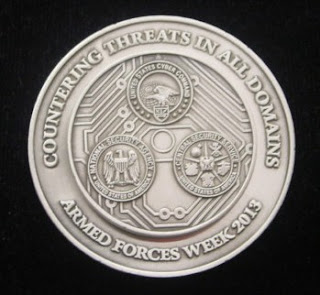One of the most frequent questions we get when designing a challenge coin is, "What is 3-D relief?" The price for 3-D coins is much higher than 2-D coins -- but the resulting coin is very different. Before you have your challenge coins made, be sure you fully understand the difference. Here is a brief explanation and photos of the 2 types of coins.
2-D, or two dimensional, is the most common way challenge coins are made. A 2-D coin has levels of metal height on the coin that are only at a 90 degree angle from base of the coins. The coin on the left is a good example of 2-D artwork. The Chief's head, chevron and the eagle are made by creating lines in the metal that are raised at a 90 degree angle.
All lettering on this coin, the stars in the outer rim and all artwork in the center circle are made from 2-D. To add color to a coin, we need these lines of metal that create a "dam" for the paint that will be injected into each area. 2-D coins can be color-filled or, as in the photo above, can be left without paint.
2-D artwork on coins is always made by raising the metal straight up from the coin. We can create multiple levels of raised areas and create a 2-D coin that looks similar to a 3-D coin. We will discuss this in more detail later.
3-D relief on coins creates the look that the artwork has been sculpted into the coin. The metal is raised and lowered at an infinite number of levels and the corners of objects can be curved and sloped.
Creating a 3-D coin is a great way to upgrade your coins. 3-D relief can be used to recreate a building, your mascot, a monument - virtually anything. And relief can commemorate a person in intimate detail.
The cost for 3-D coins is higher than a standard challenge coin for several reasons. First, we generally make the coins slightly thicker to accommodate the relief. Secondly, an extra step in the coin production process is needed for the 3-D areas of the coin to either be hand-carved by skilled artisans or created by the computer with a 3-D rendering.
The 3-D areas of a coin cannot be painted. However, we can cover 3-D areas with clear or tinted epoxy.
If you want more detail in your coins than 2-D allows, but want color added to the areas, we can accomplish this by creating a photo insert of your artwork. A sample photo insert coin can be seen to the left.
A photo insert is a great option for adding color and color blends (4 color process) to your coins. The artwork is screenprinted in full color on a metal sheet. That sheet is then die cut around the image. Then the thin metal piece is adhered to the coins. To protect the screenprinting -- we apply a layer of clear epoxy to the top. The result is a beautiful, high-end coin. As you can also see, we can cut the metal to various shapes.
Celebrate Excellence has a large
gallery of coins online where you can see many examples of all three of the coin types above. We also have a brief video online for the first-time coin purchaser --
"Coin Design 101" -- the video explains all features available on coins.
As the nation's highest rated challenge coin company -- we love answering questions about coins. Please call and ask to speak with a coin specialist - 1-800-662-8283. Or visit our
Celebrate Excellence website to learn more or to get a free no-obligation quote.
 In 2013, we introduced our "I am a First Sergeant" statue - our tribute to the men and women who accept the responsibility of being a Shirt. Today - it is our number 1 selling military statue. Proudly made in Texas - the statue is available in both male and female versions.
In 2013, we introduced our "I am a First Sergeant" statue - our tribute to the men and women who accept the responsibility of being a Shirt. Today - it is our number 1 selling military statue. Proudly made in Texas - the statue is available in both male and female versions.
















.JPG)



